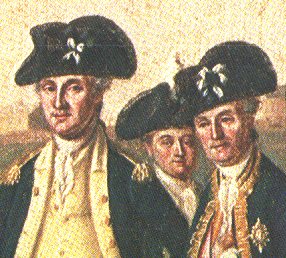
|
Painting by Louis Edouard Rioult (1790-1855), held by Musée du Nouveau Monde, La Rochelle, France.
|
|
|
The
Franco-American
Alliance
of
1778-1800
|
|
The eighteenth-century French painting presents an alegorical and idealistic view of the Franco-American alliance. France (represented in the form of a female 'diety') assists the young American nation (a female native of the 'New World') in obtaining its independence.
|
|
The French-American Alliance was based upon a treaty between the American rebels and France signed in 1778. It led to the military victory at Yorktown (1781), and arguably to full recognition of American Independence in the 1783 Treaty of Versailles. This Alliance had an 'effective life', as being of mutual value and supported by both consigning nations, from 1778 to 1783 (5 years). Its 'technical life' as a treaty was from 1778 to 1800 (22 years).
|
|
The story of this special alliance -- the only political alliance the United States entered in to during the first 173 years of existence -- is more complex than is suggested in the many casual references to it in the general accounts of the American Revolution. Seldom is the full scope of the French contribution mentioned, and many times simplistic explanations are presented as to the motives or possible consequences. See page on Perspective on the French-American Alliance for an expanded review of the subject.
|
|
|
|

|
The
'Union Cockade'
|
Detail from James Peale's painting [Washington and His Generals at Yorktown] shows Washington and Rochambeau wearing the respective black and white cockades for their armies that signified the unity of the French-American military alliance.
|
The black cockade was used in the English army and by Americans who were part of the British militia in the colonial wars before the American Revolution. As with so many other military traditions, the Americans continued wearing the black cockade ribbon for the American Continental Army.
The white cockade was that of the French Army. Upon arriving in the United States (July 1780), Rochambeau instructed his French troops to add a strip of black cloth to their white cockade to symbolize the alliance. Reportedly, Washington instructed his American soldiers to reciprocate by adding a white strip to their black cockade. The black and white cockade was referred to as the 'Union Cockade'. The cockades are shown in paintings by the contemporary American artists Charles Wilson Peale and John Trumbull, as well as in works by the French war-scene artist van Blarenberghe.
|
|

|
Return to
Expédition Particulière
page.
|
|
|
Page last revised 12 August 2008.
|
|